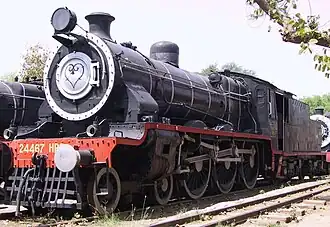| Indian XS |
|---|
 |
| Type and origin |
|---|
| Power type | Steam |
|---|
| Builder | Vulcan Foundry |
|---|
| Serial number | 4293–4296 |
|---|
| Build date | 1930 |
|---|
| Total produced | |
|---|
|
| Specifications |
|---|
Configuration:
| |
|---|
| • Whyte | 4-6-2 |
|---|
| • UIC | 2′C1′ h4 |
|---|
| Gauge | 5 ft 6 in (1,676 mm) |
|---|
| Driver dia. | 6 ft 2 in (1.880 m) |
|---|
| Axle load | 21.5 long tons (21.8 t; 24.1 short tons) |
|---|
| Loco weight | 108 long tons (110 t; 121 short tons) |
|---|
| Tender weight | 64.15 long tons (65.18 t; 71.85 short tons) |
|---|
| Fuel type | Coal |
|---|
| Boiler pressure | 225 psi (1.55 MPa) |
|---|
| Cylinders | Four (two inside and two outside) |
|---|
| Cylinder size | 18 in × 26 in (457 mm × 660 mm) |
|---|
| Valve gear | |
|---|
|
|
| Career |
|---|
| Operators | |
|---|
| Number in class | |
|---|
| Numbers | - XS1: 760, 761
- XS2: 780, 781
|
|---|
|
| [3] |
The Indian locomotive class XS was a class of experimental four-cylinder 4-6-2 "Pacific" type steam locomotives used on 5 ft 6 in (1,676 mm) broad gauge lines in British India, and then in post-partition Pakistan.[3]
The four members of the class were built by Vulcan Foundry in Newton-le-Willows, Lancashire, England, in 1930. They were divided into two sub-classes, XS1 and XS2, each made up of two locomotives.[3] Upon the partition of India in 1947, they all went to Pakistan.
See also
References
Notes
Bibliography
- Hughes, Hugh (1990). Indian Locomotives: Part 1 – Broad Gauge 1851–1940. Harrow, Middlesex: The Continental Railway Circle. ISBN 0-9503469-8-5. OCLC 21871114.
- Hughes, Hugh (1996). Indian Locomotives: Part 4 – 1941–1990. Harrow, Middlesex: The Continental Railway Circle. ISBN 0-9521655-1-1. OCLC 35135033.



